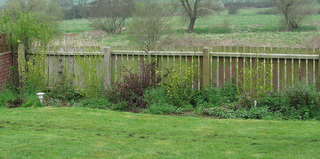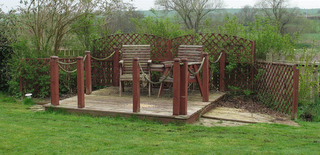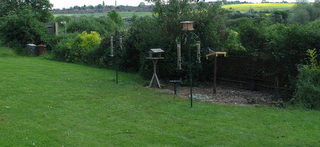The Hedgerow Project - part 1
We want to develop the garden to be both attractive to view and wildlife friendly (in particular birds). So far we have decided on four features for our garden:
- A Wild Area with tall grasses, some nettles and decaying wood, etc. This should encourage insects, snails, butterflies, etc.
- Some fruit trees with a wildflower meadow
- A vegetable patch to grow some basic vegetables for our own consumption
- A natural hedgerow, which will extend for around 26 metres along the rear boundary of the garden.
You can see here the existing fence and some of the depth of view:
In addition, in the middle of the back fence was this decking 'feature' which was very old and contained a lot of wood and concrete:
Our first job therefore was to remove this decking so it's not in the way for digging the soil, come the autumn:
You can also see the growth of the base plants and weeds in just 6 weeks, between the top and bottom pictures.
This series of posts will focus on the progress of The Hedge Project over the coming years, until we have we hope a significant source of habitat and food to support more birds locally.
Planting:
We are planning a natural hedgerow but utilising some of the existing plants including the Buddliea (which is the 'gateway' into the garden feeding area for the smaller birds). Based on a 2-deep, 26 metre long hedegrow we calculated (see this planting layout: http://handbooks.btcv.org.uk/handbooks/content/section/4263) we will need approximately 130 plants. Based on the suggested distribution (http://handbooks.btcv.org.uk/handbooks/content/section/4262) this breaks down to:
100 Hawthorns
3 Rowans
5 Hazels
2 Crab Apples
4 Roses
3 Blackthorn
4 Holly
3 Guilder Rose
2 Honeysuckle
1 Old Man's Beard
1 Damson
plus the existing Buddliea.
For the fruit trees we looked at the polination patterns (check this link for the trees and the pollination guides: http://www.hedging.co.uk/acatalog/Index_Fruit_19.html) and decided upon:
Invincible and Beth Pears, Russett and Scrupmtious Apples and Opal plum.
More useful links:
This link appears to be a reference tool for schools planting hedgerows but has some valuable advice: http://www.bornfree.org.uk/kgw/oaktree/part5hedgerow.shtml and was our first point of reference for this project.
More updates to follow in the autumn when it's time for digging and planting!


0 Comments:
Post a Comment
<< Home